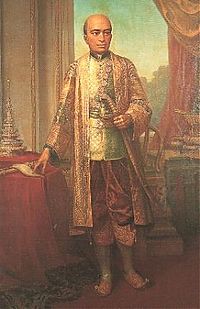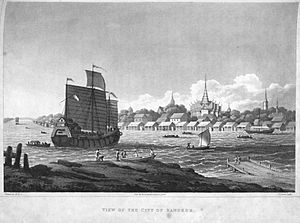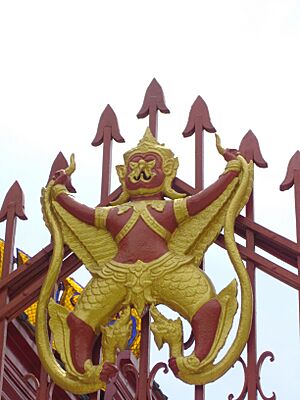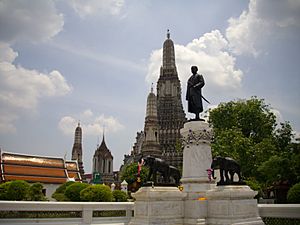Rama II facts for kids
Quick facts for kids Phra Buddha Loetla Nabhalaiพระบาทสมเด็จพระพุทธเลิศหล้านภาลัย |
|
|---|---|
 |
|
| King of Siam | |
| Reign | 7 September 1809 – 21 July 1824 |
| Coronation | 1809 |
| Predecessor | Phutthayotfa Chulalok (Rama I) |
| Successor | Nangklao (Rama III) |
| Viceroy | Maha Senanurak |
| Viceroy of Siam | |
| Tenure | 1808 – 7 September 1809 |
| Appointed | Phutthayotfa Chulalok (Rama I) |
| Predecessor | Maha Sura Singhanat |
| Successor | Maha Senanurak |
| Born | 24 February 1767 Amphawa, Samut Songkhram, Ayutthaya Kingdom |
| Died | 21 July 1824 (aged 57) Grand Palace, Phra Nakhon, Bangkok, Siam |
| Spouse | Sri Suriyendra (queen) Kunthon Thipphayawadi Sri Sulalai |
| Issue | 73 |
| House | Chakri Dynasty |
| Father | Phutthayotfa Chulalok (Rama I) |
| Mother | Amarindra |
| Religion | Buddhism |
Phra Phutthaloetla Naphalai (Thai: พระพุทธเลิศหล้านภาลัย), also known as Rama II, was the second king of Siam (now Thailand). He was part of the Chakri Dynasty. He ruled from 1809 to 1824.
King Rama II took the throne after his father, Rama I, passed away. His time as king was mostly peaceful. There were no big wars during his reign. It was a special time for Thai culture and writing. Many people called it the "Golden Age of Rattanakosin Literature." This was because King Rama II loved poetry and art. He even wrote poems himself! He supported many poets in his royal court. One famous poet he worked with was Sunthorn Phu. Sunthorn Phu wrote the epic story Phra Aphai Mani.
Contents
Who Was King Rama II?
His Early Life and Family
King Rama II was born in 1767. His birth name was Chim. He was born in Amphawa District, which is in Samut Songkhram. At that time, it was part of the Ayutthaya Kingdom.
His father was known as Luang Yokkrabat of Ratchaburi. His mother was Nak of Samut Sakorn. Later, they became King Rama I and Queen Amarindra.
In 1767, the city of Ayutthaya was attacked by invaders from Burma. Chim's father joined forces with Taksin to fight back. His father quickly became a high-ranking military leader. He led campaigns to bring Laos and Cambodia under control. In 1782, his father became King of Siam. He was later known as Rama I. Chim was given the title of Prince Itsarasunthon.
Prince Itsarasunthon had a son named Prince Tub in 1787. Prince Tub later became King Rama III. Prince Itsarasunthon also had two other sons, Mongkut (born 1804) and Pinklao (born 1808). Mongkut later became King Rama IV.
In 1807, Prince Itsarasunthon was made the Lord of the Front Palace. This was a very important position. It meant he was next in line to be king.
Becoming King of Siam
When King Rama I died in 1809, Prince Itsarasunthon became the new king. He was the oldest living son of Rama I. At first, he didn't have a special royal name. His son, King Rama III, later named him Loetlasulalai. Another son, King Mongkut, changed it to Loetlanaphalai. He is now known as Rama II. His main wife, Princess Bunrod, became Queen Sri Suriyendra.
Soon after he became king, a son of the previous King Taksin started a rebellion. He claimed he should be king. King Rama II's son, Prince Tub, quickly stopped the rebellion. This showed that Prince Tub was a strong leader. Because of this, his father gave him a higher title. He also made him the Minister of Foreign Affairs.
What Happened During His Reign?
Protecting Siam from Invasion
The Burmese king, Bodawpaya, heard that King Rama I had died. He decided to invade Siam in 1809. He marched his army into Chumphon and took over Thalang (now Phuket City).
King Rama II sent his brother, Maha Senanurak, to fight back. They successfully took back Thalang. This event is known as the "Thalang campaign." It was the last time the Burmese army invaded Thai land.
A Golden Age for Culture and Arts

King Rama II loved poetry so much that it was said if you could write good poems, you might become a favorite in his court. His reign was a time of cultural rebirth. This was especially true for arts and literature. It came after many years of wars.
Famous poets like Sunthorn Phu and Narin Dhibet worked for King Rama II. He also encouraged his own sons to write poetry. One of his sons, Poramanuchit, became a very important Buddhist leader. He was known for his religious writings.
King Rama II also helped bring back Thai culture and royal traditions. In 1811, a big royal funeral was held for King Rama I. In the same year, a sickness spread in Bangkok. King Rama II ordered special ceremonies to help stop the sickness. He also set up a new system for studying Buddhism. In 1817, the important Vesak festival was brought back.
Siam's Relationships with Other Countries
In 1810, Siam sent a group of people to China to meet the Jiaqing Emperor. This was the first time Siam had sent a mission to China since the new kingdom began.
For a long time, Siam had not encouraged many visitors from Western countries. This was after a big change in Siam in 1688. Also, wars in Europe meant there was not much contact between Siam and Western nations.
However, things started to change. The British became more interested in the Malay Peninsula. This was because their trade with China was growing. The Sultan of Kedah, who was under Siam's rule, gave Penang to the British in 1786. He did this without asking Siam. Later, the British also got Seberang Perai. Soon, the British became the strongest naval power south of Siam.
In 1818, the governor of Macau (a Portuguese colony) visited Siam. This was the first official visit from a Western country since the Ayutthaya period. The British started a new trading post in Singapore in 1819. A missionary from Yangon brought the first printing press to Siam in the same year. The Portuguese opened the first Western office in Siam in 1820. The British also sent an official visitor, John Crawfurd, in 1822.
His Death and Who Came Next
King Rama II died suddenly in July 1824. Some people thought he might have been poisoned. According to the rules, his son Prince Mongkut should have become king. However, his older half-brother, Jessadabodindra, became king on the same day.
Even though Jessadabodindra's mother was not a queen, he had a lot of experience. He had helped his father stop a rebellion. He also worked as the Minister of Trade and Foreign Relations. His experience was more important than the younger Prince Mongkut's claim to the throne at that time. Prince Mongkut did become king much later, after his elder brother.
| Monarchs of the Chakri dynasty |
|
|---|---|
| Phra Buddha Yodfa Chulaloke (Rama I) |
|
| Phra Buddha Loetla Nabhalai (Rama II) |
|
| Nangklao (Rama III) |
|
| Mongkut (Rama IV) |
|
| Chulalongkorn (Rama V) |
|
| Vajiravudh (Rama VI) |
|
| Prajadhipok (Rama VII) |
|
| Ananda Mahidol (Rama VIII) |
|
| Bhumibol Adulyadej (Rama IX) |
|
| Vajiralongkorn (Rama X) |
|
See also
 In Spanish: Buddha Loetla Nabhalai para niños
In Spanish: Buddha Loetla Nabhalai para niños



